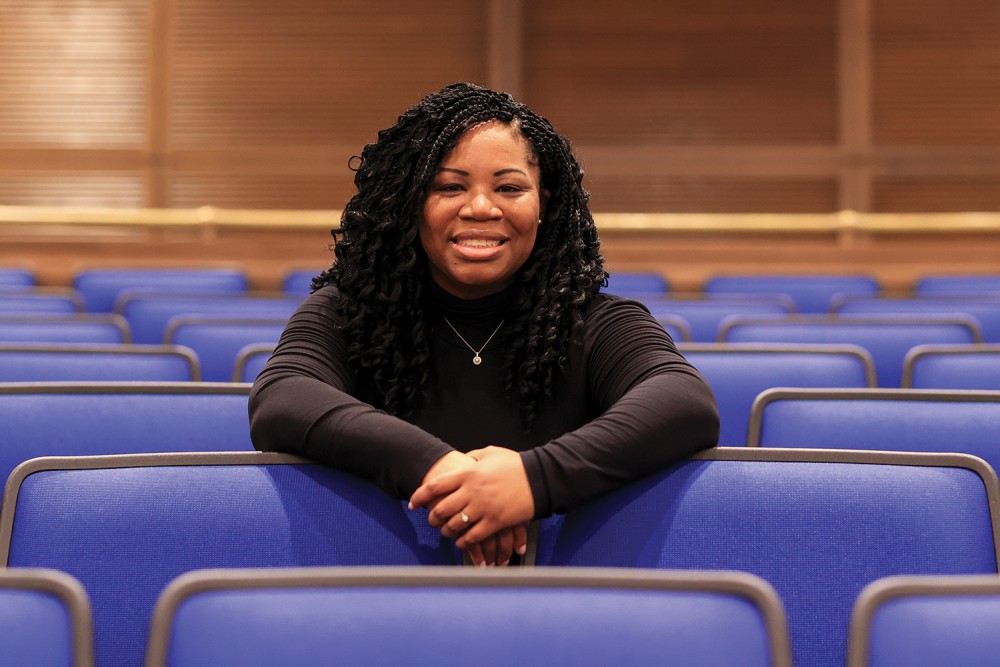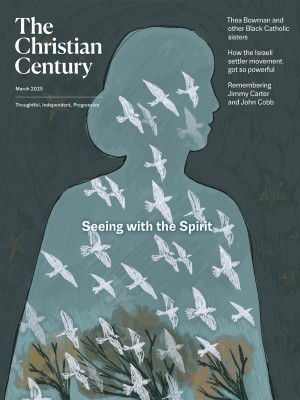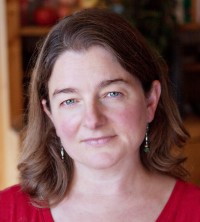America’s real sister act
“When we narrate the history of the church from the perspective of Black nuns,” says historian Shannen Dee Williams, “myths about the Catholic past fall quickly and they fall hard.”

History professor Shannen Dee Williams (AP Photo / Aaron Doster)
Shannen Dee Williams is an associate professor of history at the University of Dayton who specializes in the African American experience and Black Catholicism. She is author of Subversive Habits: Black Catholic Nuns in the Long African American Freedom Struggle. Hear the full version of this interview on the Century podcast In Search Of.
Can we start with an introduction to some of the Black Catholic sisters in your book?
Absolutely. Subversive Habits tells what I consider to be the story of America’s real sister act: the story of how generations of African American Catholic women and girls fought against discrimination and exclusion to be able to answer God’s call and minister as consecrated women of God in the Roman Catholic Church.
Read our latest issue or browse back issues.
Over 2,500 African American women have entered religious life in the US church. Three of them are currently on the road to sainthood—they’re among the “saintly six” African Americans (see “The mysticism of Thea Bowman,” page 52).
The first is Venerable Mother Mary Lange, foundress of the Oblate Sisters of Providence, the modern world’s first Roman Catholic sisterhood freely open to African-descended women and girls. It was founded in Baltimore in 1829.
Lange is one of the great revolutionary figures of the early American church. She and her friends ran a school for Black children out of her home, because the educational institutions run by the church at that time would not accept African American children. They did this to serve a community that was being neglected but also because these were women who felt called to religious life but had experienced rejection by the earliest communities of sisters ministering in the Diocese of Baltimore. The Oblate Sisters of Providence are among the earliest Catholic sisters to minister in the United States.
The second successful African American sisterhood in the United States was founded by the Venerable Henriette DeLille. DeLille too was a devout Black Catholic woman called to religious life but with no options to pursue her vocation due to the anti-Black admissions policies of the communities of sisters in Louisiana, another cradle of American Catholicism. So she and several close friends founded the Sisters of the Holy Family in New Orleans in 1842. They were the first Catholic sisterhood to have their motherhouse established in Louisiana.
Like their counterparts in Baltimore, the Sisters of the Holy Family made a revolutionary commitment to the education of Black children, both free and enslaved. The nation’s oldest continuously serving Black Catholic school is St. Frances Academy in Baltimore, which was started and run by Mother Lange’s Oblate Sisters of Providence. The second oldest is St. Mary’s Academy in New Orleans, established by DeLille.
I also want to mention Sister Mary Antona Ebo. In 1965, she was a member of the first delegation of Catholic sisters to go to Selma, Alabama, in support of Black voting rights. She famously gave an address to reporters there. The press were shocked by the presence of this Black nun among the delegation, and they wondered if she really was Black. She said very clearly, I am a Negro, and I’m very proud of it. It’s that moment that not only solidified the place of Catholic sisters in the civil rights movement but also made sure that Black sisters were there from the very beginning.
Ebo was among a handful of African American Catholic sisters who went into White communities and were forced to profess their vows in a segregated ceremony. There is actually a photograph of it. Although we see all of these iconic pictures of Catholic sisters marching for racial justice in the 1960s, I argue that the image of Sister Mary Antona making that segregated profession ceremony gives us greater insight into what it meant to be Catholic in America—not only Black and Catholic, but Catholic generally.
You write about the heartbreak many Black Catholic sisters experienced during this period. What did you discover in your research as you encountered women who had dedicated their lives to the church and then found their hearts broken?
Although I’m Catholic, I had no idea that Black nuns existed in my church. I came to this project really by chance, although the sisters would probably say it’s providential serendipity.
I came across an article that announced the formation of the National Black Sisters’ Conference, which was a Black Power federation of Catholic nuns established in wake of the assassination of Martin Luther King Jr. I experienced what I can only call a metanoia. How did Black nuns exist, and why didn’t I know about it?
The sisters who formed this conference were eager to tell their stories to the public in order to help people understand that they were there fighting for racial justice—and that if people didn’t see enough of them fighting, there was a reason for that. It’s not because they lacked a commitment to the fight. They had been in the vanguard, and yet they had been made invisible. They understood that the greatest weapon of White supremacy is not its violence but its ability to erase the history of its violence and its victims. So these women were not only active in the fight but also understood that they were being erased in the process.
So what the National Black Sisters’ Conference did was to create a vehicle to make these women and their work visible. In many of the stories that we already know—that we would consider to be these great stories of the civil rights movement—Black sisters are already there.
One of the best examples is King’s “Letter from Birmingham Jail,” in which he champions the Jesuit leaders of Spring Hill College for being the first institution in Alabama to accept African American students. What Dr. King was unaware of is that it wasn’t the Jesuits and their moral compass that was leading this effort. It was Black sisters who were ministering in Alabama and nearby Mississippi and Louisiana.
It’s not Dr. King’s fault that he didn’t know that it was Black sisters pushing the hand of the Jesuits. When we begin to narrate the story of Black sisters in the church—or simply to narrate the American Catholic experience from their perspective—what happens is that many of the stories we’ve told about ourselves are revealed to be myths. We see the role of Black sisters—their moral leadership, intellectual leadership, and educational activism—really pushing their church to initiate desegregation efforts that have often been attributed to religious orders of men or to bishops. In fact it was often Black women, and especially Black sisters, doing that critical moral and intellectual labor.
Leaders often take credit for movement work done at the grassroots level. But these women’s stories were rather intentionally erased so that we could tell other, mythological stories.
Right. When we narrate the history of the American Catholic Church from the perspective of Black nuns, myths about the Catholic past fall quickly and they fall hard. It’s why Lange’s story is so important. People have made excuses for her slave-owning and/or segregationist counterparts, whether it is Katharine Drexel, Elizabeth Seton, or Philippine Duchesne. “Oh, well, they participated in slavery, but they are just simply people of their times.” Mother Lange was also of those times. She didn’t do it. But if you erase her, you don’t even have to deal with the contradiction.
We forget that the Catholic Church was the largest corporate slaveholder in the Americas. It was the institution most responsible for the rise of African slavery in the Americas—the first global institution to say that the lives of Black people did not matter. These women go into that institution and embrace the religious state. They say that no one has a right to their bodies, that they will serve God.
This is why the story of African American sisterhoods is so powerful. It forces us to grapple with the role of the Catholic Church in the formation of anti-Blackness, in this largely unreconciled history of colonialism, slavery, and segregation. You cannot tell these women’s stories accurately and honestly without confronting those realities. And so people who are not willing to confront them erase the women.
I wonder what your work in the archives taught you about Lange’s voice. Who was she?
She was a revolutionary in every way that a visibly Black woman living in the slaveholding and segregated American Catholic Church and in the slave society of Baltimore in the 19th century could be. We have a letter she wrote shortly after the formation of her community in 1832. She’s writing to the superior of the Sulpicians, the first Roman Catholic order of priests to serve in the United States and supervisors of the Oblate Sisters of Providence. The superior has asked her to provide two sisters to serve as domestics at the Sulpician Seminary, a slaveholding community.
Understand the dangers of what has just been asked of Mother Lange. Her community of teaching sisters, who do not engage in domestic work whatsoever, are being asked to go and do the very perilous work of domestic service in a slaveholding community of priests and priests in training.
She has really no choice but to submit, but she says, we’ll do so under certain conditions: you have to create a space for my sisters to be able to live and work separately from the men. And under no circumstances will my members take food to the tables of your priests and priests in training. We have documented examples of enslaved women being sexually abused by priests. So Mother Lange is really asking for protection for these women. She’s trying to protect the women in her community from the sexual terrorism of White supremacy, of chattel slavery, of colonialism.
That gives us a very clear sense of her revolutionary mindset. We have to understand what this means for these women to say no one has a right to my body but my God, to understand celibacy as an act of Black liberation in the institution most responsible for the majority of enslavement in the nation at that time.
That letter really places you in that moment. It allows you to feel what that must have been like, getting that letter and knowing that you don’t have the right to say no and yet you can’t just say yes because there’s too much at stake for these women’s safety.
If you talk to Oblate Sisters of Providence of every generation, they are always taking the long view: we make the sacrifice now for that next generation. If she had not made that sacrifice and had said no, the bishop had the right to say, go back into the world. And so she had to protect her community while also protecting her sisters.
These women—and this is true of all of the African American sisterhoods—will tell you that they took an unofficial vow: that they would suffer gladly under the burden of White racism for the sake of their communities, for the sake of the preservation of their communities and their schools.
It’s truly a form of radical activism. It’s why when we see that image of Ebo with her counterparts marching down that segregated altar, we see that these are not people who have lost themselves in this church. These are people who are willing to suffer if they can expose the sin of White supremacy.
That really is Christianity at its root, right? That you take on the suffering in order to demonstrate what the kingdom of God really looks like.
What’s your take on the canonization process? How do you understand this movement toward the canonization of some of these figures who have been so important in the Black Catholic movement in the Americas?
I think the first thing that most Black Catholics in the US will tell you is that there are plenty of Black saints from the United States, it’s just that they have not been recognized by the church. There are a lot of people who are probably worthy of canonization whose causes may never even be launched because of the money, the politics, and the effort that it takes to get someone canonized in the modern era.
What canonization means is being recognized by the church. Because if you are formally recognized by the church, your story can be institutionalized within the church, and it becomes a global story and you’re able to rise from local origins.
In the US context, although you have a very substantial African American Catholic community—a community whose roots are just as old as anyone else’s roots in the United States—the fact that you don’t have saints from their stories contributes to their invisibility. So for many people, at a moment in which Black history is under attack, the canonization of Black saints institutionalizes not only these individuals and the histories that they embody but also the story of the Black Catholic experience itself. It is a reminder that Black history is and always has been Catholic history.






